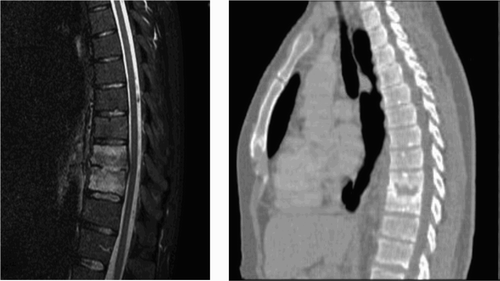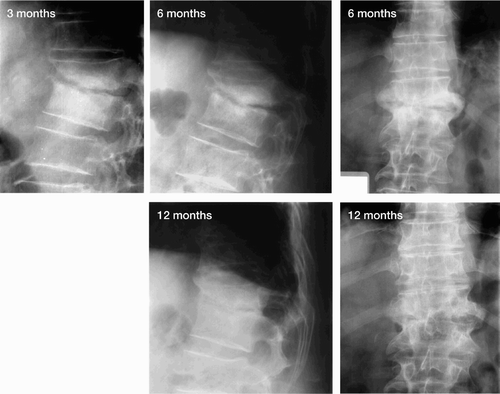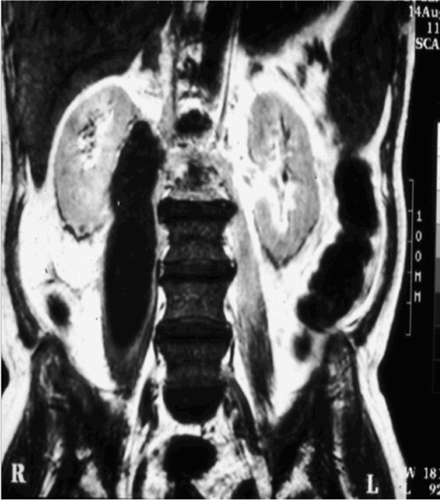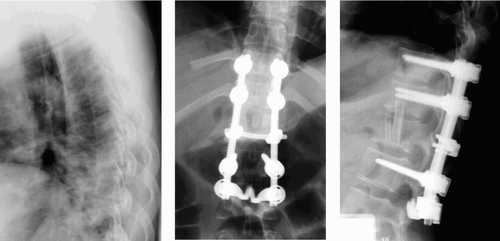Abstract
Background and purpose Spondylodiscitis may be a serious disease due to diagnostic delay and inadequate treatment. There is no consensus on when and how to operate. We therefore retrospectively analyzed the outcome of a large series of patients treated either nonoperatively or surgically.
Patients and methods Between 1992 and 2000, 163 patients (101 males) were hospitalized due to spondylodiscitis. The mean age was 56 (1–83) years. The infection was located in the cervical spine in 13 patients (8%), in the thoracic spine in 62 patients (38%), at the thoracolumbar junction in 10 patients (6%), and in the lumbo-sacral spine in 78 patients (48%). In 67 patients (41%), no microorganisms were detected. Most of the other patients had Staphylococcus aureus infection (53 patients) and/or Mycobacterium tuberculosis (22 patients). The patients were divided into 3 groups: (A) 70 patients who had nonoperative treatment, (B) 56 patients who underwent posterior decompression alone, and (C) 37 patients who underwent decompression and stabilization.
Results At 12-month follow-up, nonoperative treatment (A) had failed in 8/70 patients, who had subsequently been operated. 24/56 and 6/37 had been reoperated in groups B and C, respectively. Group A patients had no neurological symptoms. In group B, 11 had neurological deficits and surgery was beneficial for 5 of them; 4 remained unchanged and 2 deteriorated (1 due to cerebral abscess). 11 patients in group C had altered neurogical deficits, which improved in 9 of them. 20 patients had died during the 1-year follow-up, 3 in hospital, directly related with infection.
Interpretation Nonoperative treatment was effective in nine-tenths of the patients. Decompression alone had high a reoperation rate compared to decompression and internal stabilization.
Spondylodiscitis is a rare disease with a highly variable outcome. Mild cases can be treated nonoperatively. Severe cases have a substantial morbidity (back pain, deformity, and neurological deficits) and a high mortality rate regardless of advanced drug therapy and surgical intervention (Carragee Citation1997, Soehle and Wallenfang Citation2002).
Diabetes mellitus, malnutrition, substance abuse (alcohol/drug users), sickle cell anemia, immunosuppressive conditions (HIV, steroid users), tumors, renal failure, and septicemia may aggravate the final outcome of spondylodiscitis (Sampath and Rigamonti Citation1999, Reihsaus et al. Citation2000, Soehle and Wallenfang Citation2002). The most common symptoms are pain, fever, night sweats, anemia, loss of weight, malaise, and neurological symptoms due to ischemia or mechanical compression (abscess) (Reihsaus et al. Citation2000) Late diagnosis can result in general multiple organ failure and epidural abscesses (Carragee Citation1997, Hadjipavlou et al. Citation2000a, Rhee and Heller Citation2004).
The most common infectious organism is Staphylococcus aureus, followed by Streptococcus viridans, Echerichia coli, Staphylococcus epidermis, Brucella mellitensis and Proteus spp. Pseudomonas aeruginosa, Candida albicans, and viral and fungal organisms (e.g. Aspergillus fumigatus) can cause spinal infections in immunosuppressed patients and intravenous drug users (Carragee Citation1997, Rhee and Heller Citation2004). In isolated cases, Serratia marcescens and Echinococcus spp. can also be detected (Kaufman et al. Citation1980, Hadjipavlou et al. Citation2004).
The location of the infection is mainly in the lumbar spine, followed by the thoracic and the cervical spine (Rhee et al. Citation2004). Neurocompression is commonest in the thoracic and cervical region, due to the close relation of the spinal canal and dural sac (Hadjipavlou et al. Citation2000b).
Improved techniques for early diagnosis (MRI/ STIR sequence), appropriate antibiotic therapy, and surgery in selected cases have resulted both in reduced mortality and morbidity. However, there have been few studies reporting the outcome of treatment of spinal infection. The aim of our study was to analyze the effectiveness of conservative or surgical treatment in patients with spinal infection and determine the pathway of optimal surgical treatment.
Patients and methods
163 patients (101 males) with spondylodiscitis, treated in our hospital between 1992 and 2000, were studied retrospectively. The mean age of patients was 56 (1–83) years. Only 12 patients were younger than 20 years and 60% of the patients were older than 50 years. 143 patients were native Danish citizens, 16 were immigrants from Africa, and 4 were from other countries. Patients with bone metastases or primary tumors were excluded.
Evaluation prior to admission to the spinal unit
All patients had initially consulted either their GP or a district hospital. For most patients, the diagnosis of the infection before arrival at the spinal unit had been based on plain radiographs, often combined with CT or MRI. Although ideally antibiotic therapy should not be started until the organism has been identified (Grados et al. Citation2007), 100 of the 163 patients had already received antibiotic treatment for an average duration of 48 (5–194) days before being referred to us. In most of the cases, the spinal infection was related to infection elsewhere (skin trauma, upper respiratory tract, urinary tract, or gastrointestinal tract).
Evaluation after admission to the spinal unit
Our department is a referral center for spinal infections, and it covers a population of almost 1.5 million people. A spinal specialist evaluated the patients at admission. The Frankel classification was used in order to evaluate the neurological status (Frankel et al. Citation1969). The kyphotic angle and Cobb angles were measured radiographically. All operations were performed in our hospital.
The location of the infection was in the cervical spine in 13 patients (8%), the thoracic spine in 62 patients (38%), at the thoracolumbar junction in 10 patients (6%) and in the lumbo-sacral spine in 78 patients (48%). Plain radiographs with MRI and CT revealed 355 infected levels. In 15 cases, the infection was localized at a single level, in 117 it was at 2 levels, in 18 it was at 3 levels, in 6 it was at multiple levels. 7 cases were multiple-focus (). 54% of the patients with cervical spine infection and 65% of those with thoracic spine infection were operated on.
Table 1. Level distribution in 163 patients with spinal infection
Concomitant disease was common: diabetes mellitus in 16 patients, chronic obstructive lung disease in 14 patients, cancer in 12 patients, drug addiction in 20 patients, and other diseases (poor nutrition, chronic steroid use, alcohol addiction, lupus erythematosus, rheumatoid arthritis, ankylosing spondylitis, immunosuppressive conditions, HIV infection) in 33 patients. 26 patients had 2 or more concomitant diseases. 9 cases were classified as iatrogenic infections; 4 of these were related to epidural catheters/spinal punctures and 5 occurred postoperatively, 2 of them following discectomy.
A CT-guided bone biopsy (Christodoulou et al. Citation2005, Hadjipavlou et al. Citation2004) was performed in 31 patients but the culture was positive for microorganisms in only 16 patients, perhaps because of previous use of antibiotics. In all patients who were operated, bone samples for histology and culture were taken during surgery. Overall, bacteria were isolated in 74 patients and tuberculosis was found in 22 other patients ().
Table 2. Microorganisms identified
Nonoperative treatment (group A; 70 patients) ( and )
Criteria for nonoperative treatment were: no neurology, no clinical manifestation of unstable spine, no kyphosis, and good heath status. In 15 patients, the infection was located at one level. The patients received intravenous antibiotic therapy for 4 weeks followed by oral antibiotics until clinical and laboratory findings had normalized (usually for 1–6 months).
Figure 2. Pretreatment radiograph (left) and CT-guided biopsy (right) from a patient treated nonoperatively.
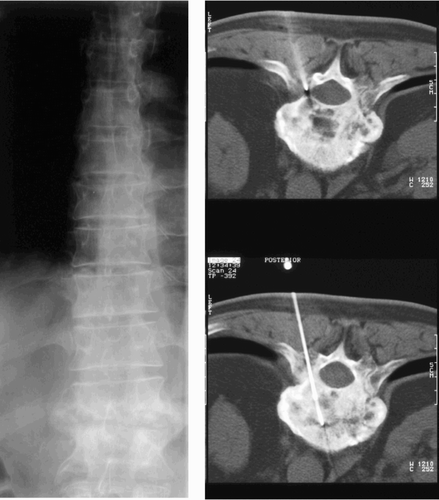
The choice of the antibiotic was based on the results of culture. The patients with negative bacteriological findings followed a protocol consisting of dicloxacillin sodium and gentamycin (initially intravenously) for at least 1 month.
The patients with tuberculosis were given isoniazid 300 mg × 1 per os, rifampicin 450 mg × 1 per os, ethambutol 1,200 mg × 1 per os, and pyrazinamid 2,000 mg × 1 per os for 1 year.
All patients treated conservatively used a cast brace for mean 13 (11–17) weeks in order to support the infected spine and to prevent deformity.
Surgical treatment (93 patients) (–)
The indications for surgical treatment were: extensive bone destruction (kyphosis of > 15 degrees), the presence of an epidural abscess, neurological deterioration, and failure of nonoperative treatment (persistent pain and fever, and persistent abnormal C-reactive protein and erythrocyte sedimentation rate). None of the patients was enrolled for two stage operation.
Figure 5. Preoperatively, with evidence of kyphosis. Postoperatively during hospitalization, at 6 months, and B at 12 months
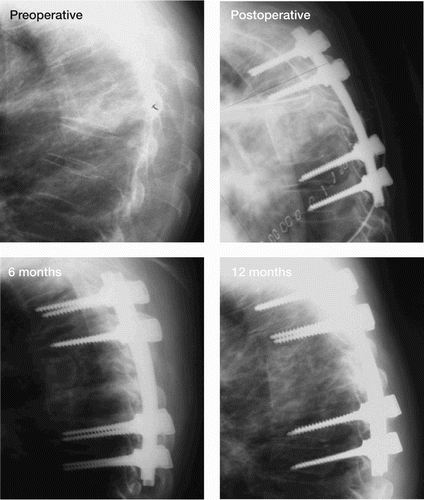
Figure 7. At 6 months (upper left panel), at 12 months (upper right panel), and after removal of the instrumentation at 2 years (bottom two panels).
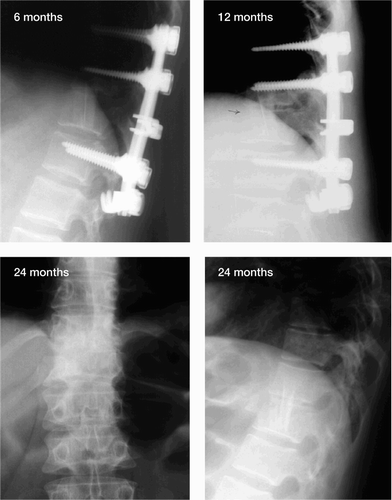
In group B (56 patients) ( and ), a posterior decompression was performed. The infection was located at 2 levels in 45 cases. 1 patient died in hospital and 6 died during follow-up. The location of the infection was lumbo-sacral in 32 patients and thoracic in 21 patients.
The extension of the decompression depended on the extent of the destruction/abscess. In multiple- level infections, bilateral extensive laminectomies were preferred. Wide decompression was used for extensive single-level infections in order to allow a clear view and complete removal of the foci of infection.
In group C (37 patients) (–), the decompression was followed by stabilization. The location was thoracic in 17 patients, lumbo-sacral in 11, and cervical in 5. In 29 cases, the infection was located at 2 levels. 1 patient died in hospital and 4 died during the follow-up.
A posterior approach for both decompression and stabilization was used in 31 patients. 4 patients underwent an anterior decompression and stabilization and 2 patients were decompressed through both an anterior and a posterior approach, followed by circumferential stabilization.
Pus was drained and the infected bone masses were debrided, followed by decompression and bone grafts were used in all cases to increase the percentage of fusion.
We did use cages in the primary treatment; these were used solely in cases of revision surgery.
In 33 cases, a posterior instrumentation with posterolateral bone graft was used and in 4 an anterior Kaneda stabilization system was used. A postoperative brace was used in 17 cases.
Results
The patients were reviewed on a regular basis at 3, 6, and 12 months. 20 patients died during the first year: 3 in hospital from complications related to the spinal infection, 8 within 6 months, and 9 within 1 year. The latter 15 patients died from causes not directly related to the infection.
One-quarter (38/163) of the patients required further operative treatment during the first year (). A reoperation was performed in onethird (30/93) of the patients who underwent surgery. 8/70 patients in group A required reoperation to control infection and stabilize the spine. All had normal neurology. 24/56 group B patients were reoperated with debridement and stabilization. In contrast, only 6/37 patients in group C were reoperated.
Table 3. Revision of the initial treatment
During treatment, in the patients without complications the markers of infection (WBC, CRP, and ESR) gradually normalized earlier in group A than in groups B and C.
Neurological status ()
All 70 patients in group A had normal neurology. In group B, 33/44 patients had normal neurology and 11 had altered neurology (incomplete data in 12 patients) after the decompression which was beneficial in only 5 cases. In group C, 20/31 patients had normal neurology and 11 had neurological impairment (incomplete data in 6 patients). Their status improved postoperatively in all but 2 cases.
Table 4. Breakdown of neurological status
Complications
3 patients died during hospitalization due to multiorgan failure. Other complications during hospitalization were: pulmonary embolism (2 patients) atelectasis (2), postoperative hematoma (2), paralysis of the diaphragm (1), cardiological problems (4), and cerebral thrombosis (1). In addition, 3 patients had residual psoas abscess, 2 had pancreatic abscess, 1 had cerebellar abscess (altered neurology), and 3 had pulmonary infection.
After the 1-year study period, 15 patients were re-admitted to hospital and had further surgery related to their spinal infection. Of the 4 patients in group A, 3 underwent posterior stabilization due to progressive kyphosis and 1 patient underwent posterior decompression due to spinal stenosis. Of the 7 patients in group B, 4 underwent posterior stabilization due to progressive kyphosis, 2 underwent posterior decompression due to spinal stenosis, and 1 underwent anterior stabilization with a cage due to progressive kyphosis. Of the 4 patients in group C, 1 underwent revision of the metalwork due to hardware failure; in 1 patient the posterior fusion was converted to a circumferential (360°) fusion; 1 patient had vertebral traumatic fracture at a level adjacent to the instrumentation, which was treated with an extension of the stabilization; and 1 patient developed a reinfection at an adjacent level, requiring an extension of the decompression and the posterior instrumentation.
Discussion
In our series, spinal infections were more often located in the lumbar spine, neurological complications were commoner in the thoracic and cervical spine, many patients were old and had other diseases or drug addiction, the infection was commoner in men, and Staphylococcus aureuswas the most commonly identified microorganism, thus confirming previous findings (Carragee Citation1997, Hadjipavlou et al. Citation2000b, Reihsaus et al. Citation2000, Chen et al. Citation2004, Hadjipavlou et al. Citation2004, Rhee and Heller Citation2004, Curry et al. Citation2005, Lohr et al. Citation2005, Pereira and Lynch Citation2005).
The incidence of staphylococcal infections in our series (33%) is similar to that in a previous study (34%) (Beronius et al. Citation2001), but is lower than in most of the previously mentioned studies. We believe that this is related to the fact that in our series, only 47% of bone biopsies were positive for microorganisms—probably because many of the patients had been on antibiotic therapy prior to referral to our unit.
The second most common microorganism in our study was Mycobacterium tuberculosis(22/163 patients). Although this finding contrasts with the results of a recent literature review (Reihsaus et al. Citation2000), other studies have shown that tuberculosis is still causing spinal infections (predominately thoracic) despite extensive global vaccination programs (Turgut Citation2001, Curry et al. Citation2005, Pereira and Lynch Citation2005, Christodoulou et al. Citation2006).
Of the 163 patients, 38 (23.3%) required further treatment, which is less than a recently reported figure of 48% (Curry et al. Citation2005). It is interesting that none of these patients was younger than 20 years of age.
In cases with mild clinical symptoms and absence of neurological impairment (group A), nonoperative management was adequate to control the infection, as reported by other authors (Reihsaus et al. Citation2000, Rhee and Heller Citation2004, Nene and Bhojraj Citation2005). We reoperated 8/70 patients in this group, a rate in-between what has been reported in other series (Curry et al. Citation2005, Nene and Bhojraj Citation2005). In retrospect, we miscalculated the severity of the infection in 7 cases, which should have been stabilized from the beginning.
Of the 93 patients who were operated, 30 required revision surgery. This was mainly related to the fact that single posterior decompression, although sufficient in order to control the infection, did not prevent progression of deformity. A similar reoperation rate was presented in a paper by Lohr et al. (Citation2005) involving 27 patients.
Posterior laminectomy with the purpose of decompressing the spinal canal or wide decompression may destabilize the spine. In our series, decompression alone failed in nearly half of the patients and for that reason we abandoned it as a stand-alone operation. However, for isolated small abscesses or in cases with high co-morbidity, percutaneous techniques and transpendicular discectomy are promising for the control of infection and vertebral destruction (Hadjipavlou et al. Citation2004).
In 37 patients with vertebral collapse and extensive abscess formation, we combined decompression with anterior debridement and reconstruction with structural bone graft (from ribs or iliac crest) and posterior or anterior stabilization. The use of implants carries risks, but it supports the instrumentation and accelerates bone fusion (Carragee Citation1997, Curry et al. Citation2005, Lohr et al. Citation2005). We found no complications with this technique.
Early diagnosis was related to better outcome, specifically in patients with neurological deficits. Our policy was to offer patients with deteriorating neurology emergency surgery within 24 h of admission. The overall neurological outcome of our study was similar to that reported in a review paper (Reihsaus et al. Citation2000), and it is also comparable with other published series (Hadjipavlou et al. Citation2000b, Lohr et al. Citation2005). Other studies have shown better results (Schinkel et al. Citation2003, Pereira and Lynch Citation2005).
In our series, 20 patients (12%) died during the 1-year follow-up, which is similar to what has been reported in many other studies (Carragee Citation1997, Reihsaus et al. Citation2000, Tang et al. Citation2002). Other authors have reported lower or negligible mortality rates (Schinkel et al. Citation2003, Lohr et al. Citation2005, Pereira and Lynch Citation2005).
Acknowledgement
Mr George Drosos and Mrs Linda Marie Nygaard made the appropriate correction as linguistic personnel.
No competing interests declared.
Contributions of authors
CB, BEL, ESH, KH, PH, and BN were the surgeons who recruited the patients, decided on the treatment, and performed the operations. PH also retrieved the images from the X-ray files. ASK and BEL prepared the initial database. EJK updated it and analyzed the data; he also wrote the manuscript. CB and KH revised the manuscript.
- Beronius M, Bergman B, Andersson R. Vertebral osteomyelitis in Goteborg, Sweden: a retrospective study of patients during 1990–95. Scand J Infect Dis 2001; 33(7)527–32
- Carragee E J. Pyogenic vertebral osteomyelitis. J Bone Joint Surg (Am) 1997; 79(6)874–80
- Chen H C, Tzaan W C, Lui T N. Spinal epidural abscesses: a retrospective analysis of clinical manifestations, sources of infection, and outcomes. Chang Gung Med J 2004; 27(5)351–8
- Christodoulou A, Zidrou C, Savvidou O D, et al. Percutaneous Harlow Wood needle biopsy of the spine: a retrospective analysis of 238 spine lesions. Orthopedics 2005; 28(8)784–9
- Christodoulou A G, Givissis P, Kataglis D, et al. Treatment of tuberculous spondylitis with anterior stabilization and titanium cage. Clin Orthop 2006, 444: 60–5
- Curry W T, Hoh B L, et al. Spinal epidural abscess: clinical presentation, management, and outcome. Surg Neurol 2005; 63(4)364–71
- Frankel H L, Hancock D O, Hylop G, et al. The value of postural reduction in the initial management of closed injuries of the spine with paraplegia and tetraplegia. Paraplegia 1969; 7(3)179–92
- Grados F, Lescure F X, Senneville E, et al. Suggestions for managing pyogenic (non tuberculous) discitis in adults. Joint Bone Spine 2007; 74: 133–9
- Hadjipavlou A G, Bergquist S C, Chen J W, et al. Vertebral Osteomyelitis. Current Treatment Options in Infect Dis 2000a; 2: 226–37
- Hadjipavlou A G, Mader J T, Necessary J T, et al. Hematogenous pyogenic spinal infections and their surgical managemen. Spine 2000b; 25(13)1668–79, 1
- Hadjipavlou A G, Katonis P K, Gaitanis I N, et al. Percutaneous transpedicular discectomy and drainage in pyogenic spondylodiscitis. Eur Spine J 2004; 13(8)707–13
- Kaufman D M, Kaplan J G, Litman N. Infectious agents in spinal epidural abscesses. Neurology 1980; 30: 844–50
- Lohr M, Reithmeier T, et al. Spinal epidural abscess: prognostic factors and comparison of different surgical treatment strategies. Acta Neurochir (Wien) 2005; 147(2)159–66
- Nene A, Bhojraj S. Results of nonsurgical treatment of thoracic spinal tuberculosis in adults. Spine J 2005; 5(1)79–84
- Pereira C E, Lynch J C. Spinal epidural abscess: an analysis of 24 case. Surg Neurol 2005; 63(Suppl 1)S26–9
- Reihsaus E, Waldbaur H, Seeling W. Spinal epidural abscess, a meta analysis of 915 patients. Neurosurg Rev 2000; 23: 175–204
- Rhee J M, Heller J G. Spinal infections. The adult and pediatric spine3, J W Frymoyer, S W Wiesel. Lippincott Williams and Wilkins. 2004; 165–89, chapter 10
- Sampath P, Rigamonti D. Spinal epidural abscess, a review of the epidemiology, diagnosis and treatment. J Spinal Disord Tech 1999; 12: 185–92
- Schinkel C, Gotward M, Adress H J. Surgical treatment of spondylodiscitis. Surg Infect (Larchmt) 2003; 4(4)387–91
- Soehle M, Wallenfang T. Spinal epidural abscesses, clinical manifestation, prognostic factors and outcomes. Neurosurgery 2002; 51(1)79–85
- Tang H J, Lin H J, Liu Y C. Spinal epidural abscess-experience with 46 patients and evaluation of prognostic factors. J Infect 2002; 45(2)76–81
- Turgut M. Spinal tuberculosis (Pott's disease): its clinical presentation, surgical management, and outcome. A survey study on 694 patients. Neurosurg Rev 2001; 24(1)8–13
